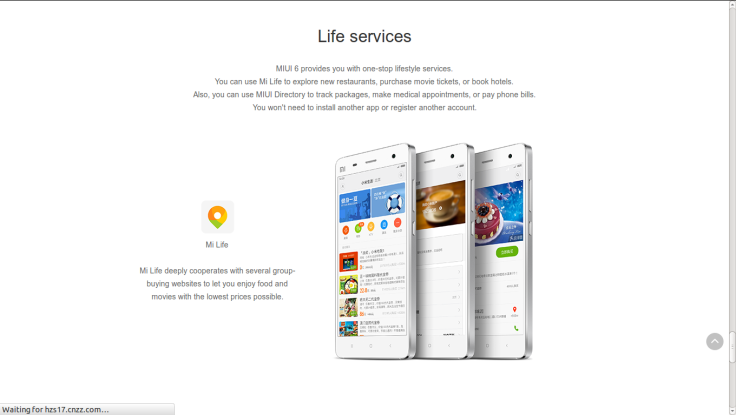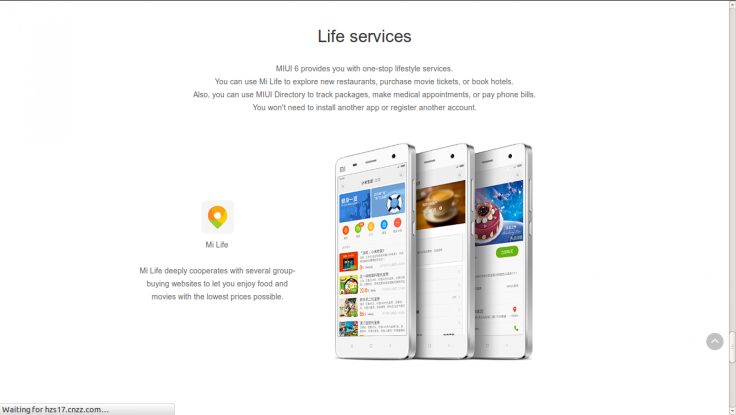How China Became A Smartphone Powerhouse: Huawei, Xiaomi, ZTE Set To Challenge Apple Inc., Samsung

The global smartphone industry is undergoing a major shift as Chinese manufacturers begin wielding international power and making headway against market leaders like South Korea's Samsung and California-based Apple. Figures released this week by CounterPoint Research show that of the top 12 smartphone manufacturers, nine are based in China and together account for more than a third of the world's total smartphone market.
Many of these vendors, like Xiaomi, Huawei and ZTE, have benefited from the Chinese government's initiatives aimed at growing the country's tech industry. The question now is whether these companies can sustain their recent growth despite headwinds such as a lack of patents and few relationships with wireless carriers in the West.
Chinese smartphone makers have enjoyed several competitive advantages. Firstly, they have benefited, and still do, from government support. For example, they have been able to utilize the manufacturing infrastructure in Shenzhen, a purpose-built city that caters to electronics makers, and thus build smartphones with flagship-standard specs at very low cost. In addition, Beijing offers domestic smartphone makers tax breaks and relaxed labor and environmental standards.
Secondly, they run lean. While companies like Samsung and Sony are able to source cheap components for their smartphones, they also have significant overhead, including bloated employee numbers, legacy infrastructure and huge marketing budgets. Upstarts like OnePlus, on the other hand, are much more lean. "We don’t burn a lot of money so we don’t need to sell a lot of phones to break even,” co-founder Carl Pei told International Business Times. OnePlus also sells its smartphones directly to consumers, so it doesn’t have the same channel costs -- which can be up to 20 percent of margins -- as some of its competitors.
Thirdly, they have a huge customer base in their backyard: China is the world’s biggest smartphone market. It has more than 715 million people online, according to Internet Live Statistics, and more than 85 percent of those access the Internet on their smartphones.
But as the Chinese market becomes saturated, can these relatively unknown manufacturers replace more established names like Sony, Samsung and LG? Manufacturers like Huawei and ZTE may be recognizable to some people in the U.S., but other names on the list of top global smartphone brands -- like Xiaomi, Oppo, Vivo, Meizu, CoolPad and LeTV -- will be complete unknowns. Nevertheless, these unknowns are now selling more smartphones than the likes of HTC, Sony and Microsoft.
Huawei
Huawei is the world’s third-biggest smartphone manufacturer behind the two giants who dominate the smartphone market, Apple and Samsung. Huawei gets the majority of its revenue from networking equipment, but in the last couple of years has made a concerted effort to push into smartphones. Initially, Huawei made budget white label smartphones for networks around the world. But today it is making some of the most interesting devices on the market and has recently been granted the seal of approval from Google, partnering with the search giant to make the Nexus 6P.

Huawei has had some success expanding beyond its home territory, especially in Europe, but in the U.S. it remains an outsider, primarily thanks to a House Intelligence Committee ruling in 2012 that the company “cannot be trusted to be free of foreign state influence.” Huawei has denied any links to the Chinese government -- and has attempted to be more transparent -- but the criticism has stuck and the company has so far failed to make a major impact in what is the world’s second-biggest smartphone market. Huawei has made the first steps in a U.S. marketing push, announcing a sponsorship deal with the Washington Redskins last year. So far, though, it has had little impact. "North America remains a weak spot for Huawei and it needs to focus on the region if it has to narrow down the gap between the top two smartphone brands," CounterPoint analyst Tarun Pathak said.
ZTE
Huawei was not alone in receiving criticism from the U.S. government in 2012. ZTE, another rising Chinese company, was also criticized. But it has overcome the stigma and is now the fourth-biggest smartphone brand in the U.S. behind Samsung, LG and Apple, which is based in Cupertino, California. ZTE was able to blunt the negative press about its links to the Chinese government (which relate to it being founded by a group connected to China’s Ministry of Aerospace) because millions of people were using ZTE phones in the U.S. without knowing it, thanks to deals with mobile phone networks that sold ZTE phones under their own brands.
Leveraging its deep connections with the carriers, the company then began pushing its own branded phones and, thanks to successful sponsorship deals with the likes of the New York Knicks and the Golden State Warriors, it has become an established player. In a reverse of Huawei’s global push, ZTE is now targeting the European market next as it tries to attain its stated goal of becoming the world’s second-biggest smartphone manufacturer within five years.
Xiaomi
Xiaomi (pronounced shoo-me and meaning "little rice") is best described as an Internet company selling everything from connected weighing scales, to headphones and smart air purifiers. Still, it is best known for its smartphones, and over the last 12 months it has become one of the top five smartphone makers -- despite selling in only a handful of countries. For years Xiaomi was criticized for copying Apple’s design features, and there is no doubt its products and marketing marketing material have taken some inspiration from Cupertino.

But comparing it to Apple is not entirely fair. Xiaomi produces premium quality phones priced aggressively and uses a proprietary version of Android. The company is more like Amazon, selling content through its suite of app, game, music and film stores, while it has also just dipped its toe into the mobile payments market.
Unlike ZTE and Huawei, however, Xiaomi faces major hurdles to become a global smartphone powerhouse. It simply doesn’t have the deep cache of patents of its compatriotsl as of March the company had just two U.S. patents. Further, its business model of selling directly to the consumer will only get it so far. In countries like the U.S., where 90 percent of the market is dominated by carriers, it could struggle. Xiaomi has already seen its star wane in its second-biggest market, India, where sales dropped 46 percent, year-on-year, in the second quarter of 2015.
Oppo, Vivo And OnePlus
While Huawei and ZTE have their ownership models scrutinized for links to Beijing, many other Chinese companies also have interesting origins. Oppo and Vivo, which are both among the top 10 smartphone sellers globally, are actually smartphone brands owned by BKK Electronics, a company that makes a wide range of products, including televisions and MP3 players. BKK Electronics sells mainly in Russia, but in the U.S. it offers computer accessories and storage media under the Memorex brand.
Like most Chinese smartphone makers on the list, both Oppo and Vivo offer premium smartphones at low prices with the brands' sudden rise credited to “the strong performance in the domestic China market as well as other South Asian markets,” according to CounterPoint's Pathak.
One Chinese brand not among the top 10 but which has made a major impact around the world is OnePlus. It was established by two former Oppo executives who wanted to focus on design. OnePlus is actually a subsidiary of Oppo and so, in turn, another subsidiary of BKK Electronics.

There is a trend among Chinese smartphone companies to create separate brands that are focused on specific markets or specific price points. OnePlus is clearly aimed at trying to bring the Chinese smartphone experience to markets like the U.S. and U.K., while Huawei’s Honor brand is aimed at emerging markets and budget-conscious consumers. Honor products have been extremely successful, accounting for one third of all Huawei sales.
Powered By Android
Of course, behind all of this success sits Google's Android software, which is powering the whole Chinese smartphone revolution, but without any of Google's services -- and subsequently without vendors having to pay Google a fee for using it. While a report last week suggested Google would launch a version of its Play Store in China next year, plans remain sketchy, and it is highly unlikely the Chinese government will simply lift its ban on Google completely.
This, however, creates a problem for those companies who want to expand beyond China, as it will require them to either negotiate with Google to get its services installed on the phones, look elsewhere for alternative operating systems such as Windows 10 or Cyanogen or build out their own services for overseas customers.
The Chinese government has worked hard to promote the country's smartphone industry by offering companies favorable conditions, including tax breaks and relaxed labor and environmental standards. A report published in September by Taiwan Ratings Corp, a Taipei-based subsidiary of Standard & Poor's, said that "China's enormous IT market, favorable government policies, and advancing technology capability will continue to support the expansion of China's technology sector."
The problem is that as these smartphone brands look outside of China for growth, they will face much tougher conditions, especially in countries like South Korea and the U.S., which are the home territories of Samsung and Apple, respectively. Another challenge facing these companies is the threat of patent litigation. That's especially an issue for vendors like Xiaomi, which is very young, having shipped its first smartphone just over four years ago.
Alex Wilson, partner at IP litigation firm Powell Gilbert LLP, told IBT, "By launching its product range in the U.S. and U.K., Xiaomi would be entering rough seas where the fins of the major patent holders are already circling. They are certainly not the first to dive in, as HTC, Samsung, ZTE and Huawei have all taken the plunge in recent years."
In a bid to help these companies grow internationally, Chinese Premier Li Keqiang earlier this year revealed the government's 10-year "Made in China 2025" plan, which aims to promote products made within the country's borders and is designed to transform China from a manufacturing giant into a world tech power by focusing on innovation, green development and quality goods.
Whether it's all enough to turn companies like Huawei, ZTE and Xiaomi into global players remains to be seen.
© Copyright IBTimes 2025. All rights reserved.




















